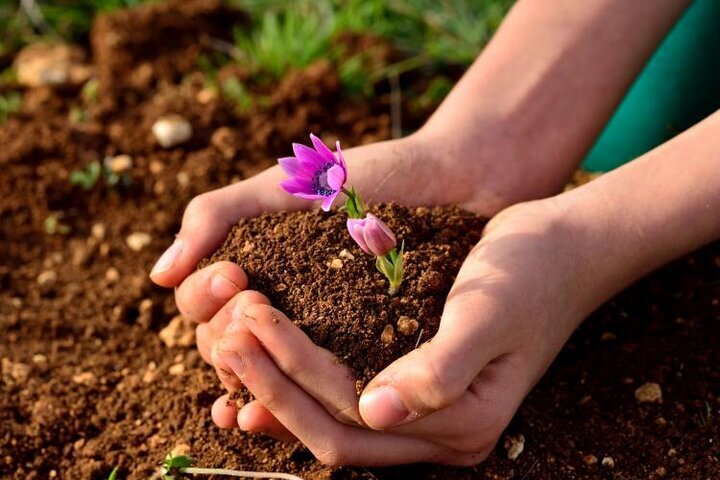Soil erosion rate five times global average

TEHRAN – “Soils: Where food begins” is the theme of World Soil Day this year, highlighting soil protection, however, Iran faces soil erosion five times the global rate.
Soil supports life on the planet by providing essential nutrients to plants. It is also home to a large, diversified community of creatures that enhance the soil’s structure, recycle vital nutrients, and aid in the management of weeds, plant pests, and diseases.
Another crucial factor is that good soil reduces climate change by preserving or even increasing soil organic carbon. All plants used in food production grow on soil, which also serves as the foundation of food systems.
December 5 is observed as World Soil Day to highlight the value of healthy soil and to promote the sustainable management of soil resources.December 5 is observed as World Soil Day (WSD), to highlight the value of healthy soil and to promote the sustainable management of soil resources. World Soil Day enjoins individuals to consider sustainably managing soil resources.
The main goal of the day is to increase public awareness of the significant environmental issues that soil degradation can lead to, such as erosion, the loss of organic matter, and a drop in soil fertility.
Considering the importance of the issue, the Department of Environment (DOE) has organized an international conference on soil protection, industry, and food security, according to IRNA.
“The importance of soil protection in providing food security and in the development of oil and petrochemical industries”, “strategies to prevent soil pollution by oil, gas and petrochemical industries”, “investigating the effects of hydrocarbon pollution on the structure and function of soil ecosystems and food security” and “the application of modern technologies and knowledge in monitoring, protection, and cleaning of soils contaminated with hydrocarbon substances” are the main issues to be discussed at the conference.
The DOE is also implementing national, and international programs and large-scale projects centered on the management, protection, and sustainable exploitation of soil in a way that guarantees the preservation and improvement of the quality of the soil, and its 22 priorities in the resolution have been approved by the cabinet.
Soil and jeopardizing food security
Ladan Razi, caretaker of the environmental protection and water management office of the DOE said that the policies for the protection and management of sustainable exploitation of the soil specified were formulated and announced according to Article 2 of the Soil Protection Law.
A plant growing in polluted soil absorbs the contamination, which is said to jeopardize food security. When the soil is depleted by pollution or erosion, soil production stops, so that, the food supply will suffer both in terms of quality and quantity, which endangers food security, she explained.
She went on to note that the next issue was Article 18 of the Soil Protection Law, which was approved and announced; In fact, the prevention of soil pollution is the main approach in this law, which emphasizes that pollution should not occur from the beginning.
The rate of soil erosion in Iran is four to five times the world standard; In fact, 16.7 tons per hectare per year, she lamented.
The soil texture of our country is mostly clay with a negative charge; Therefore, when a negatively charged pollutant compound such as nitrate enters the soil, the soil cannot absorb or keep it, and with a simple washing, it enters the underground water and contaminates drinking water sources, she further explained.
Annual loss of $56 billion
According to the statistics, Iran loses 2 billion tons of soil annually, according to the 2018 report of the United Nations Development Program, the total amount of global soil erosion is 24 billion tons, so one-twelfth of all global soil erosion occurs in Iran.
This is while, Iran has about one percent of the world's land area, which means that its erosion rate is eight times higher than the global average, so Iran is suffering from severe degradation and soil erosion.
In Iran, due to the severe erosion, it takes an estimated 800 years to produce a centimeter of soil, so the attention of the people and the government should be on average twice the global average.
Each ton of soil is valued at $28 in terms of metal ores, so the loss of two billion tons of soil annually means an annual loss of $56 billion, which is more than revenues from the sale of oil and agricultural products, gardens, livestock, poultry, and fisheries.
Home to over 25% of biodiversity
This natural resource hosts over 25 percent of biodiversity and about 90 percent of living organisms spend part of their life cycle in the soil; it also plays an important role in supporting animal biodiversity above ground, including wildlife and domesticated livestock.
The most widely recognized function of the soil is its support for food production. It is estimated that 95% of our food is directly or indirectly produced on the soil. Healthy soil supplies the essential nutrients, water, and oxygen that our food-producing plants need to grow and flourish.
Soil is also crucial for ensuring the continued growth and maintenance of natural and managed vegetation, including diverse forests and grasslands and the huge breadth of species and varieties that are cultivated or managed for their food, feed, fuel, fiber, and medicinal products.
FB/MG
